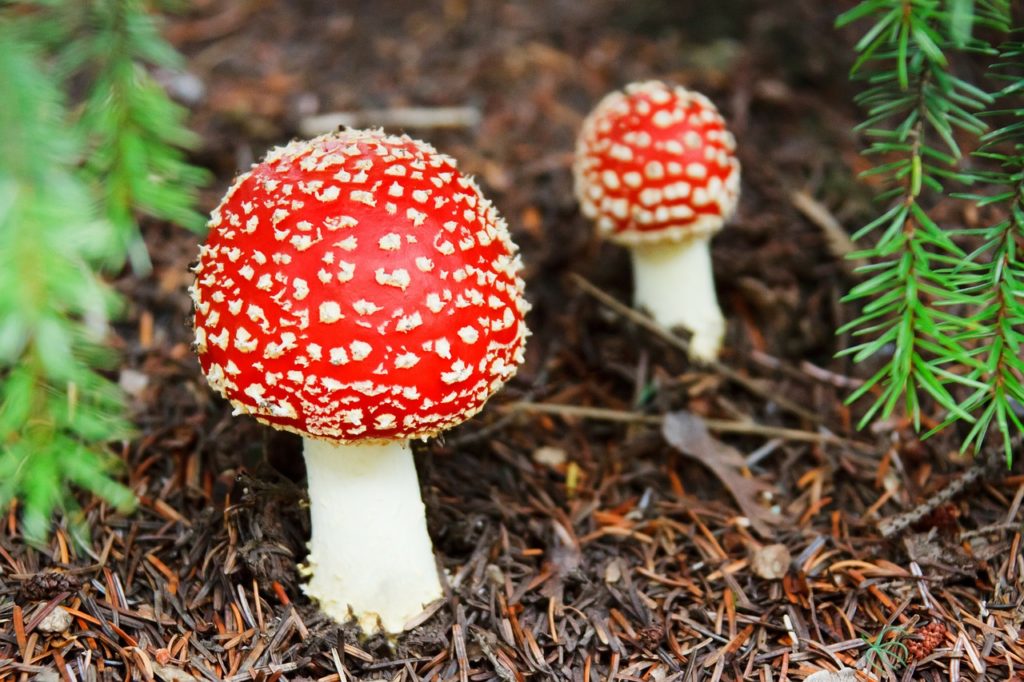From mushrooms, cheese, and bread to beer, wine, and sake, fungi play an important role in the foods we eat, whether we know it or not. These incredible organisms and their products can be great food sources that are packed with protein. Most people are already familiar with mushroom species with fruiting bodies such as the shiitake, truffles, and morels. Fruiting bodies are the part observed above ground that can sometimes be safely consumed by humans (though some are also highly toxic!). Yeast are another group of fungi important for both food and beverage fermentation – the process that converts sugars into alcohol and carbon dioxide.

Bracket Fungus. Image Source: Pixabay
Similar to how humans have domesticated dogs, cats, and many farm animals, microbes and fungi have also been domesticated. Anyone a fan of cheese? It turns out, without cheese fungi and bacteria your favorite cheese wouldn’t exist. The earliest evidence for cheese-making lies in 6th century Poland, where only lactic acid bacteria (LAB) were added to fresh milk to promote curdling. Since then, many mechanical advancements and experimentation with heat, grinding, pressing, and maturing of these cheeses, coupled with different fungal species, have allowed for the unique and wide variety of cheeses found today in stores.
There are a few key organisms for each type of cheese, and each are known in the cheese world for their particular use. For example, two species involved in cheese-making are Penicillium (Eurotiales) and Scopulariopsis, both from the group of fungi known as Ascomycota. Some Penicillium species are responsible for production of blue cheeses and soft cheeses like Brie and Camembert. Species of Scopulariopsis help to make uncooked harder cheeses, such as Tomme de Pyrénées and Ossau-Iraty. Interestingly, some fungi have been isolated specifically for making cheese, while others just happen to thrive in this environment. Penicillium roqueforti is an organism that, at first, simply grew during the blue cheese making process, but now a lab strain is added and carefully controlled to ensure the cheese matures consistently between batches.
Yeast, a common baking ingredient without which bread dough would never ferment and rise to become fluffy and delicious, is also a fungus. The baker’s yeast, Saccharomyces cerevisiae, is widespread throughout many natural and human environments, and, as a result, the origin of this species is still unknown. Genetic engineering of the baker’s yeast has allowed this fungi to withstand many baking “stressors” (such as high sugar content, freezing, and drying) while simultaneously allowing them to grow bigger at a faster rate, which is ideal for fast-rising dough.
For all the beer enthusiasts out there, in addition to water, hops, and malt, fungi (yeast) are one of the four main ingredients to create the most widely consumed alcoholic beverage in the world. Interestingly, the Saccharomyces genus is again the most widely used. Ales are brewed at higher temperatures with S. cerevisiae, which float to the top during the brewing process. Historically, ales could be brewed all the time, but lagers, on the other hand, required brewing at lower temperatures and were restricted to brew only during the colder months of the year. Lagers are made with the lager yeast, S. pastorianus, which sink to the bottom. Although these two yeast are the most common, there are many other strains of organisms used (including lactic acid bacteria and acetic acid bacteria) to brew beers, and each make their recipe unique. So the next time you raise a glass, thank the fungi who made your drinks possible!

The rare truffle mushroom. Source: Scott Darby, Flickr
Unlike yeast, the most famous and prized edible mushrooms, truffles, are very difficult to grow. The most valuable truffles are the Piedmont white and Périgord black varieties. The growth cycle of truffles is extremely complex, so creating and maintaining the right growth conditions is difficult. Scientists and truffle growers are working together, using advanced biological techniques, to find the best methods for growing these valuable organisms and many others like them.
Together, fungi are essential for a wide variety of food and beverages. With advancements in scientific techniques and cultivation strategies, fungi may become even more important sources of food in the future.


